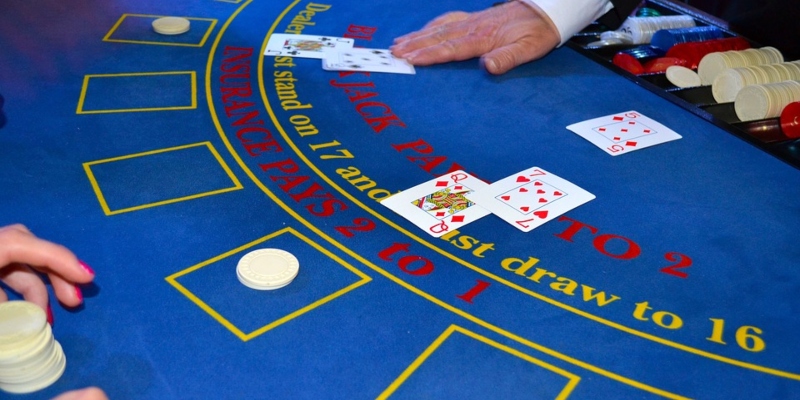The History Of Table Games
 Source: englishlikeanative, Pixabay
Source: englishlikeanative, Pixabay
While slot machines are probably the most common games in casinos, table games are by far the most prestigious. There’s something about the dealer, the green felt and the crowds of players that accentuate the glitz and glamour of the casino world. But this wasn’t always the case. Table games have come a long way in the last few hundred years. Even the most modern online casino can trace its history back to these old table games. Let’s explore a little of how these games are played and what has made them such enduring classics.
Blackjack: History and rules
When playing Blackjack players attempt to score closer to 21 than the dealer with as few cards as possible. Players bet and are then dealt two cards. They then take turns to “hit” for another card, or “stay” with their current cards. Going above 21 is a “bust” which means they instantly lose. Beating the dealer results in being paid out based on their bet.
The origins of the game are murky at best. It’s commonly believed that Blackjack was invented in 18th century France. The basis for this theory is a game called Vingt-en-Un, a name which when translated means twenty-one.
Vingt-en-Un came to North America by way of colonists from France. The game really took hold after 1931 and the legalisation of gambling in Nevada. Around this time casinos offered a special kind of bet that allowed 10-to-1 bets to players who were dealt the Ace of Spades as well as either the Jack of Spades, or Jack of Clubs. This rule was known as Blackjack. The special betting rule didn’t last long, but the name did. Blackjack had its name.
As Blackjack became more popular many players became more interested in how to do better at the game. To improve their odds, some players began keeping count of the cards dealt from the deck during play. An industrious mathematician by the name of Edward O. Thorp was the first person to form this tactic into a formal code. In 1962, Thorp released a book titled Beat the Dealer which laid out his code for card counting. The book was a bestseller and saw a surge in the number of Blackjack players. Casinos saw an upswing in business but also had to introduce new tactics to counter Thorp’s card counting system.
Roulette: History and rules
Roulette is played by attempting to predict where a Roulette ball will come to rest after going around inside a spinning Roulette wheel. Players place bets by putting chips on whichever number or numbers they think the ball will stop on.
Roulette was originally invented by Blaise Pascal, a 17th century French inventor, mathematician and physicist. Pascal invented the Roulette wheel by accident while trying to create a perpetual motion machine. Pascal adapted his new Roulette wheel into a game of chance and introduced it to gambling houses in France.
Roulette saw a surge of popularity in the 19th century. This was thanks to Francois and Louis Blanc, a pair of French brothers who removed the double zero pocket from the wheel. With just one zero pocket on the wheel the house’s odds of winning were effectively halved. This meant the odds of the game were made slightly better for players. This single zero version of Roulette became known as European Roulette.
European Roulette made its way to America during the 19th century after it was brought in by European settlers. Casino owners were quick to add the double zero back into the game in order to increase the house odds for their own benefit. This version of Roulette is now known as American Roulette.
Baccarat: History and rules
Every hand of Baccarat is played between the player and the banker, each of whom must try to score on or close to the number nine. Players bet on whichever side they think will win. They may also bet on a tie. A big difference from other card games is that Aces count as one, while tens and face cards only count as zeroes. All other numbered cards still count as their usual value.
The history of Baccarat is still under debate. Several differing theories believe the game’s origins might come from places as far apart as China, Ancient Rome, or 13th century Italy. Whatever its origin, it's likely that the rules of Baccarat were formalised in France during the late 1400s.
The invention of the printing press would have a profound effect on the development of the game. Up until the printing press came along, games of chance using cards had been few and far between because of the difficulty of making cards. The press allowed cards to be made much more quickly and easily. Card games became widely popular and many non-card games were adapted to work with cards. It’s very likely that Baccarat was one game adapted in this way..
It’s believed that Baccarat was first played in America during the late 19th century, but only really took hold in the early 1900s. It was not as popular of a casino game as Blackjack or Craps and as such was not so widely played. Baccarat became more formally entrenched as a casino game in 1959 after Tommy Renzoni introduced a version called Punto Banco in Las Vegas. Punto Banco originated in Argentina and has become the most widely played version of Baccarat to date.
All this and more
It’s indisputable that table games like Blackjack, Roulette and Baccarat have made places like Las Vegas the gambling hotspots that they are today. But players don’t need to travel to Las Vegas to enjoy some of what has made these games such classics. Playing in an online mobile casino will let players get into the action no matter where they are in the world. It’s really a testament to the quality of these games just how far they’ve come from such humble beginnings.

 Register
Register  Login
Login 



